Aircraft Can Age More Gracefully : Overconfidence Misled Us, but Older Planes Will Be Rebuilt
The noxious image of the junker automobile, ravaged by age and neglect, chugging and clanging its way down American roadways, has long been with us.
It’s an image that also haunts the car-conscious American mind when questions arise about the continued use of aging jetliners. And such questions have been rudely thrust upon us within the last year by several spectacularly frightening accidents.
When, for instance, an extremely fatigued Aloha Airlines Boeing 737 shed its upper cabin structure south of Maui last April--yanking a senior flight attendant, Clara Lansing, to her death--it was a shocking loss of innocence. The industry and the Federal Aviation Administration had always assumed that metal fatigue problems in older airplanes--mainly cracking around rivets, delamination of aluminum-skin segments and corrosion--could always be discovered by routine maintenance inspections long before they grew into a major failure. The Aloha accident quite simply destroyed our blanket faith in that assumption, and the horrifying loss of nine passengers in the blowout of a cargo door in a well-maintained, middle-aged United Airlines 747 south of Honolulu on Feb. 24, while still under investigation, has underscored the same worries.
As the phrase “the aging fleet” is used more and more, the incorrect and scary image of old, deteriorating airliners chugging and lurching their way through the sky like some sort of airborne junker, shedding parts and passengers in the process, has become very worrisome. But while there are problems to be solved quickly, the idea that badly deteriorated and marginally safe airplanes are becoming commonplace is patently false.
It is true that the average age of the U.S. airline fleet has gone up 21% in the past 10 years. It is also true that because of economic disruption born of deregulation’s ill-conceived competitive blood-letting (now largely over), airlines have been slow to order new airplanes. Now the wait for a new jetliner can be measured in years. In the meantime, older airliners are needed to fill the public demand for airline seats. The airline fleet is aging, but an airplane’s age by itself is not a reliable measure of its safety.
A modern jetliner theoretically has no inherent limit to its usable lifetime, provided it is properly inspected and maintained throughout that lifetime. But the Aloha experience taught us that the aging process could cause certain types of structural deterioration faster than our long-established inspection procedures could find them. We did not know, for instance, that many small cracks along an aging fuselage could become so widespread that an explosive decompression would, in effect, “connect” the cracks, blowing off the roof rather than a 30- or 40-inch flap of skin. We did not realize that our best electronic inspection techniques were so tedious to perform that they were effective only for conducting spot checks of a fleet and could fail to detect many developing structural problems. And we did not realize how many times the physical inspections we demanded (through non-mandatory service bulletins and mandatory airworthiness directives) could either not be done, or were being done inadequately, by airline maintenance departments. We did not, in other words, understand that the process of inspecting an aircraft for developing safety problems was not an adequate substitute for early repair of known, damage-prone areas. That industrywide mistake is now being corrected.
What it boils down to is this: If the inspection processes are not sufficient to find the problems in time, then certain parts of an aging aircraft must be rebuilt at predetermined flight-hour or flight-cycle levels. Last month the Air Transport Assn.’s working group on aging transport--the leading joint industry-government effort on the subject--recommended essentially that solution. When implemented by FAA, it should go a long way toward solving the problem.
The reason these problems were not sufficiently addressed in time, however, illuminates some profound lessons--lessons that run to the heart of how we deal with an increasingly technical society.
The system failed because we had grown dangerously overconfident, placing blind trust in the ability of our technology to anticipate all potential structural problems and investing inordinate confidence in the ability of our investigatory and regulatory agencies to discover, understand and correct problems with aging aircraft before they threatened passengers.
And, in pursuit of free-market ideological purity, too many people discounted for too long the warning signs that deregulatory disruption was having detrimental effects on many aspects of the safety system.
So far, those mistakes have cost the life of Clara Lansing of Honolulu and perhaps the missing nine passengers from Flight 811. But because of the laudable and rapid response of a chastened airline industry during the past year, we can be hopeful that the list will end there. It is up to all of us, however, to apply these costly lessons wherever we place extensive faith in our technology, whether dealing with aviation, earthquake preparedness, our space program, nuclear power, or any other vital technical/scientific discipline.
More to Read
Inside the business of entertainment
The Wide Shot brings you news, analysis and insights on everything from streaming wars to production — and what it all means for the future.
You may occasionally receive promotional content from the Los Angeles Times.










